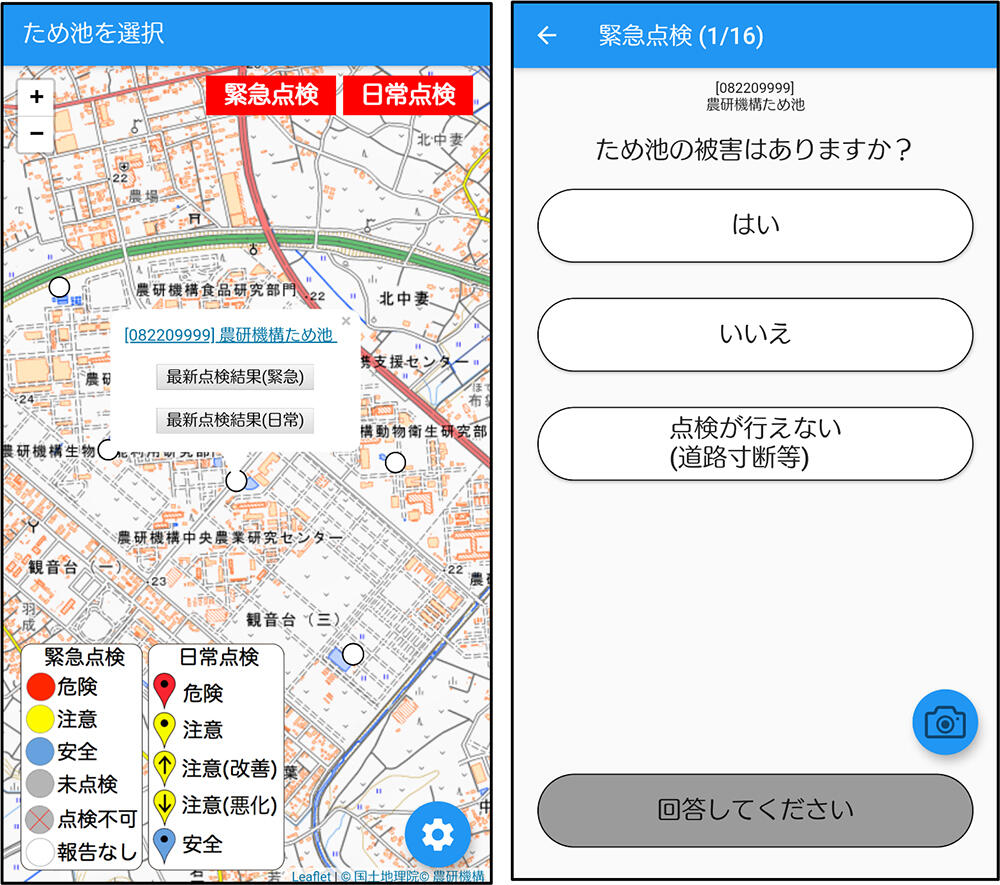The research group led by Group Leader Toshikazu Hori of the National Agriculture and Food Research Organization (NARO) Institute for Rural Engineering Division of Facilities and Geotechnical Engineering announced on June 24th that it had developed a smartphone app called "Irrigation pond management app" that allows for easy inspection and reporting by irrigation pond administrators. It is expected that the app will link with the "Support system for the prevention of irrigation pond disasters" operated by the government for government agencies, allow for data on the damage situation at the time of a disaster to be easily shared among disaster-prevention personnel, and lead to rapid disaster support from the national and local governments. Currently, it is only available to irrigation pond administrators and can be downloaded from the "App Store" and "Play Store."
Irrigation ponds are artificial ponds created for the purpose of securing agricultural water in areas with low rainfall and no large rivers. There are about 160,000 such irrigation ponds in Japan. About 70% of them were created before the Edo period and are used as important water resources. However, because irrigation ponds are created by filling small rivers and streams with soil to dam the water, there is a risk of flooding due to heavy rain. The Great East Japan Earthquake in 2011 and the heavy rain in northern Kyushu in 2017 in particular caused enormous secondary damage due to the collapse of irrigation ponds.
For this reason, the Ministry of Agriculture, Forestry and Fisheries (MAFF) designated approximately 60,000 locations as "disaster-prevention priority irrigation ponds" for "irrigation ponds where houses and public facilities exist in the flooded area in the event of a collapse and may cause human damage." For each irrigation pond, the irrigation pond manager performed facility management and daily inspections for the farmers in their area, and in the event of a disaster, the results of the emergency inspections were mainly reported to the local government by telephone.
In 2019, NARO developed a "support system for the prevention of irrigation pond disasters" that shares information on the damage situation such as information about collapsed irrigation ponds during an earthquake or heavy rain among disaster-prevention personnel nationwide, and MAFF has been operating it since 2020. It is a system that extracts data on dangerous irrigation ponds and shares report results on the Internet, which are used by national and local governments. However, in the event of a large-scale disaster, it is difficult for the national and local governments alone to quickly reflect data from a huge number of reports on many irrigation ponds, and even if the irrigation pond administrator were to directly access the system, it was expected that the system would go down due to access concentration and information security problems would arise.
To combat these issues, the research group has developed an "irrigation pond management app" that can share information, although it is a different system from the "support system for the prevention of irrigation pond disasters." The national government, local governments, and irrigation pond managers have collaborated to build a system that can manage irrigation ponds. By separating the system, access concentration and security problems can also be avoided.
The developed app can be used not only for emergency inspection reports in the event of a disaster but also for daily inspection reports. If an emergency inspection or routine inspection is chosen, it can be reported easily by answering in a simple question-and-answer format. It is designed to be easily handled by the irrigation pond managers of aging farmers. Photographs at the time of the inspection can also be sent easily. It can also be used even when communication is poor, and the input result can be sent as soon as communication is restored (an automatic setting is possible).
In the event of a disaster, the irrigation pond administrator can receive messages from the national and prefectural offices through the push notification function, and the irrigation pond administrator can conduct an emergency inspection and report. The presence or absence of reports from the irrigation pond administrator and the results of the risk assessment after inspection are color-coded on the map and displayed in an easy-to-understand manner. Use of the app requires an initiation QR code distributed by the municipality and is therefore not generally available except for irrigation pond managers. Personal information is not collected.
Using this app, irrigation pond managers can expect rapid disaster support, and this is expected to reduce the burden on administrative personnel and also enable a disaster response other than inspections. Group Leader Hori said, "If we can motivate people to install this app and use it on a daily basis, we may be able to improve disaster-prevention awareness. We would like to popularize this app, with one of our aims being easier collaboration with government agencies in the event of an emergency."

Credit: NARO
This article has been translated by JST with permission from The Science News Ltd.(https://sci-news.co.jp/). Unauthorized reproduction of the article and photographs is prohibited.




